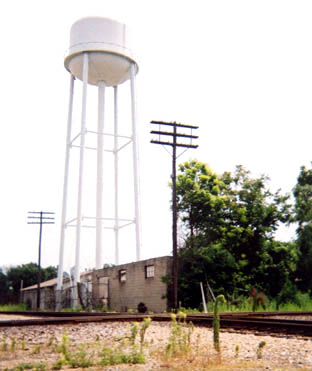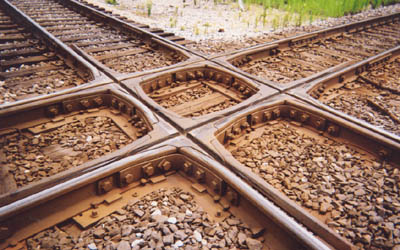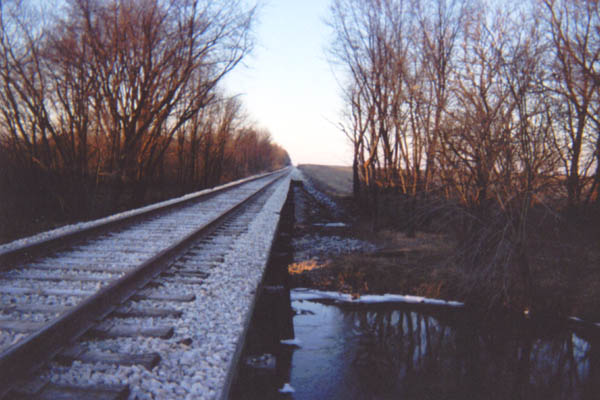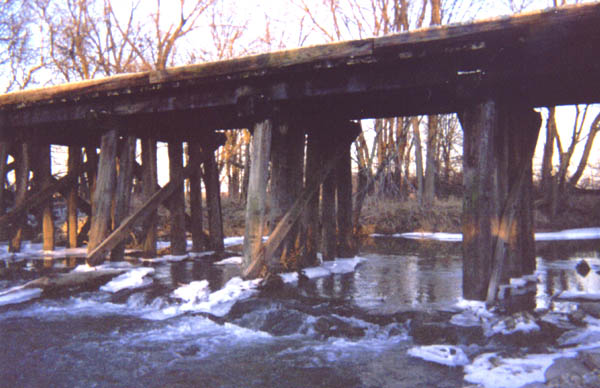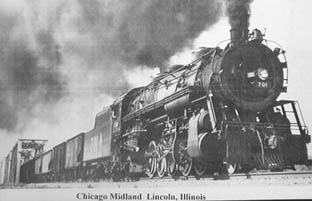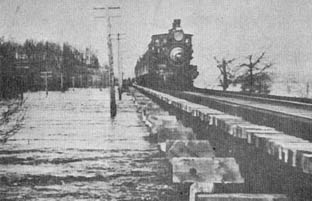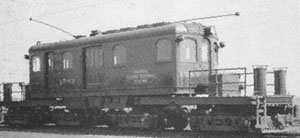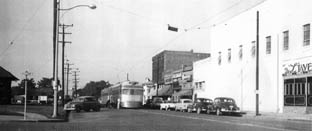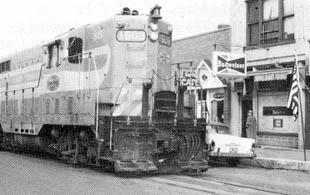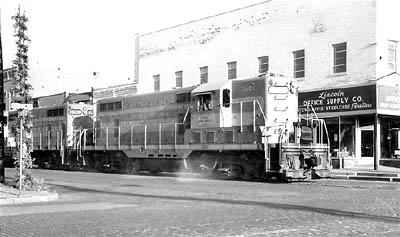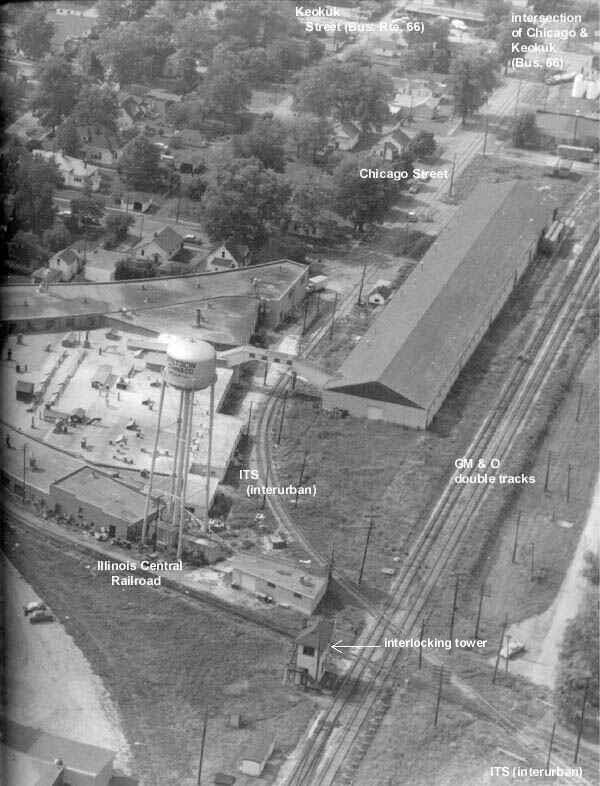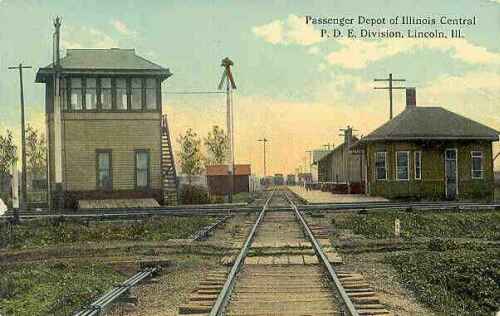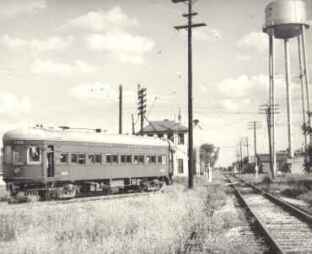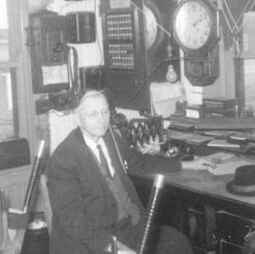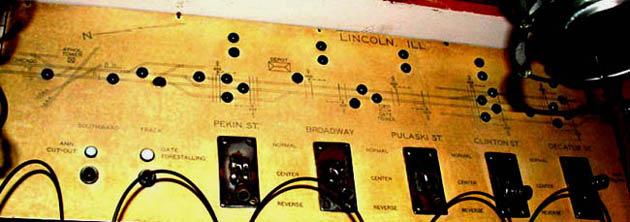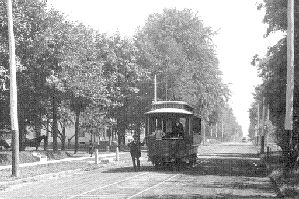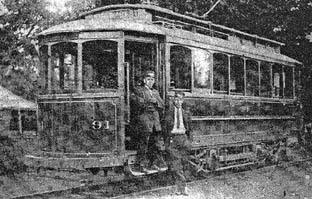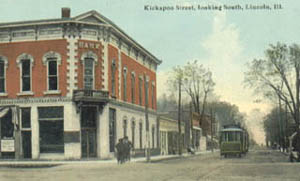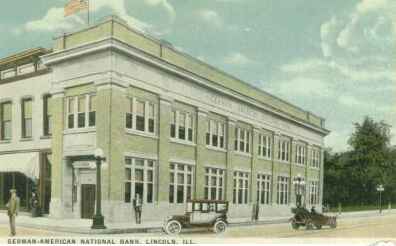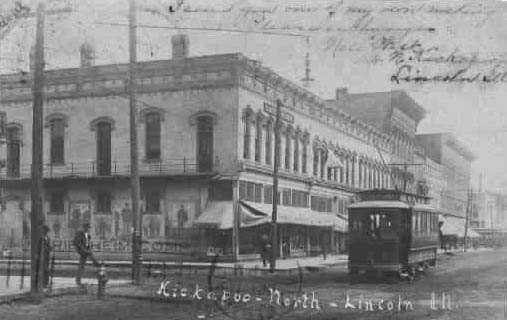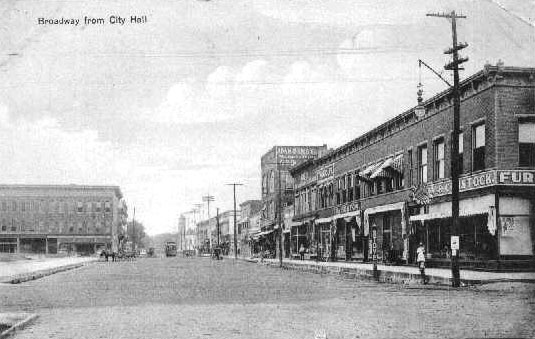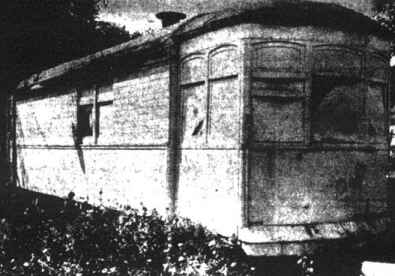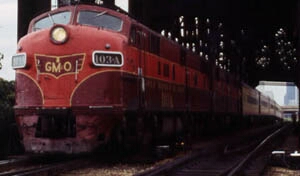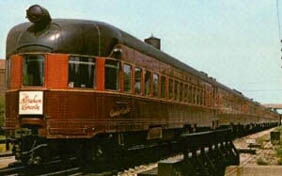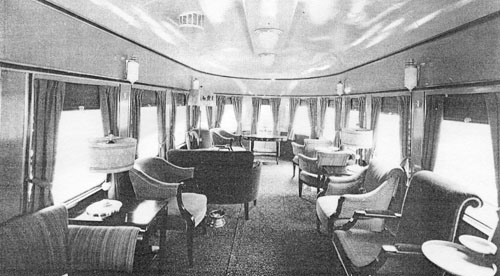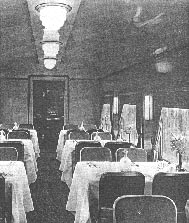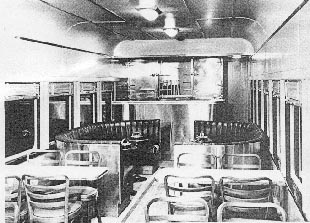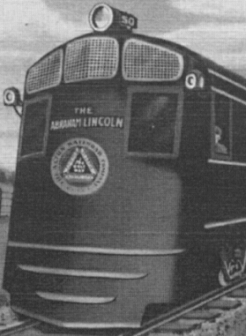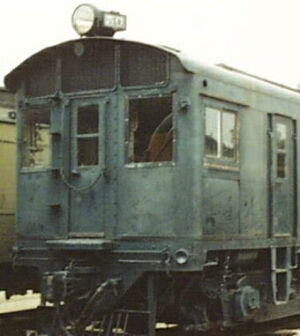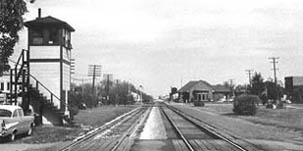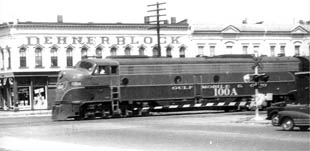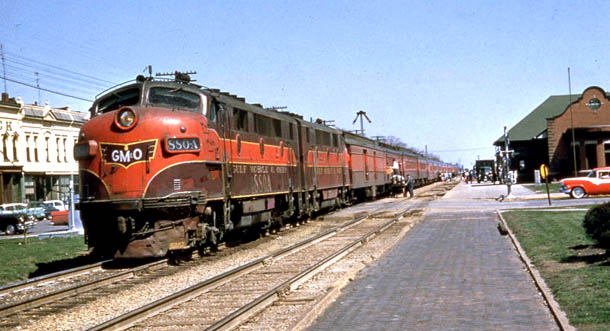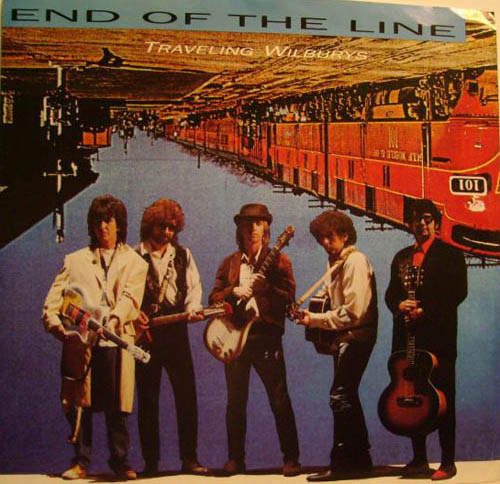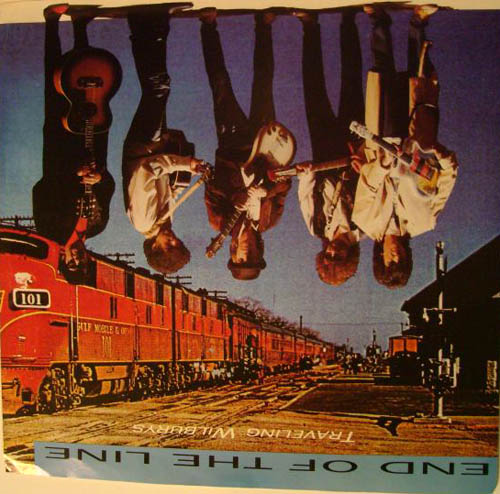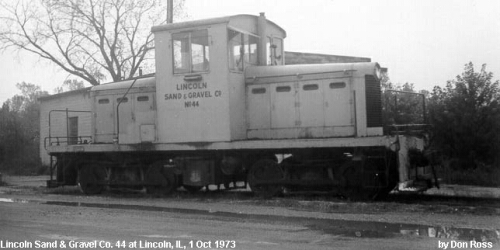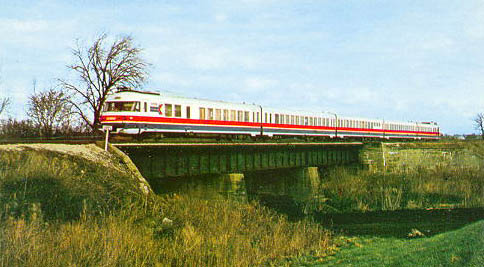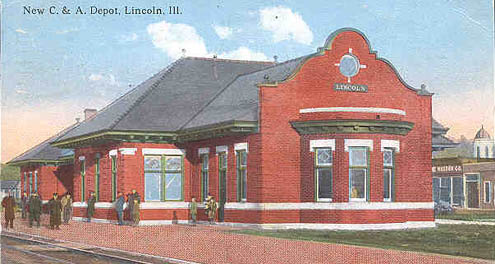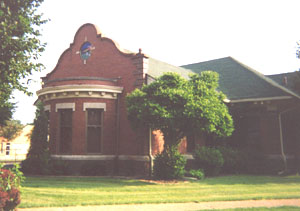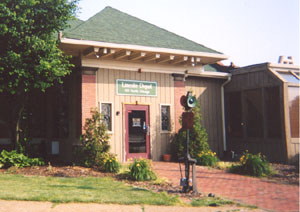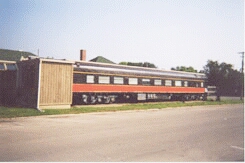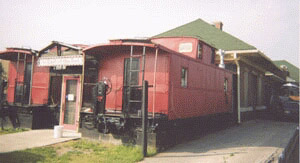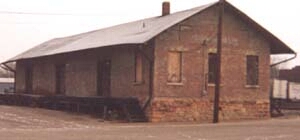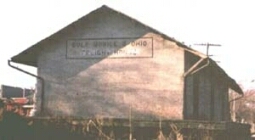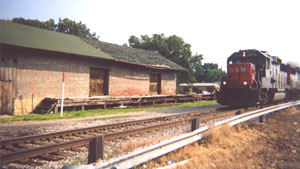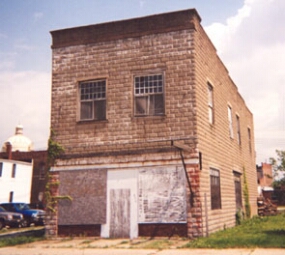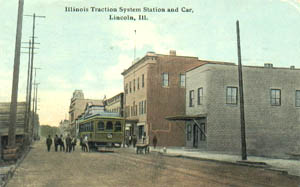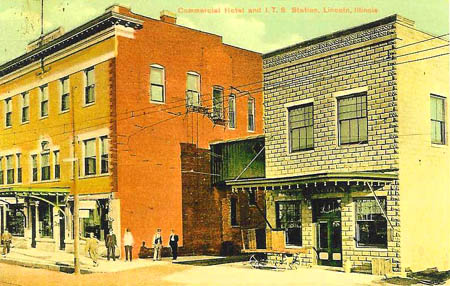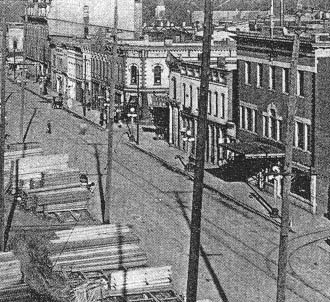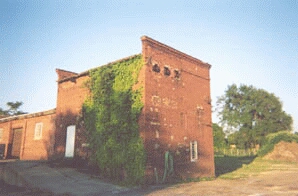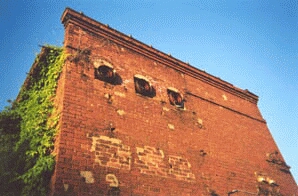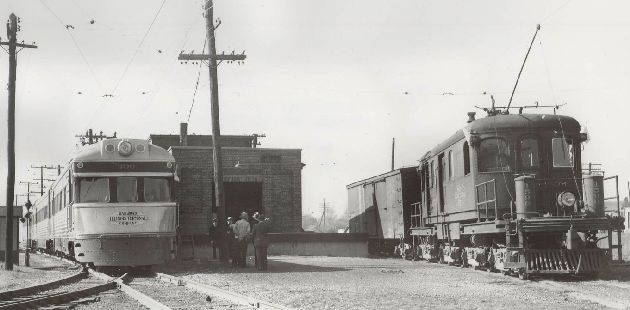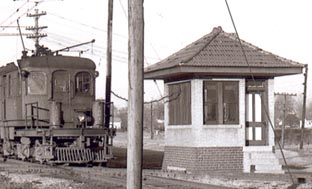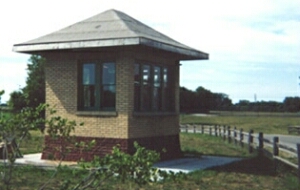
1860 photo taken 4 days after Mr.
Lincoln visited Lincoln, Illinois, for the last time. Info at 3 below.
This President
grew;
His town does too.
Link to Lincoln:
Lincoln & Logan County Development Partnership
Site
Map
Testimonials
Abraham Lincoln Bicentennial Commission of Lincoln, IL
|
Email a link to this page to someone who might be interested. Internet Explorer is the only browser that shows this page the way it was designed. Your computer's settings may alter the display.
April 24, 2004: Awarded "Best Web Site of the Year" by the Illinois State Historical
Society
|
|
|
|
Marquee Lights of the Lincoln Theater, est. 1923, Lincoln, Illinois |
|
|
|
7.
The Living Railroad Heritage of Lincoln, Illinois: |
|
7.1:
Intersection of Amtrak/Union Pacific and Illinois Central Railroad Tracks; (Leigh Henson photo, 7-2004) Name four things from the past seen in the above photo. Then identify the one that may provide a key resource for Lincoln's future growth and development. Answer: the Stetson China Company water tank, the concrete block wall from one of Stetson's buildings, the utility poles (which date to the early 20th century), and the railroad tracks of Amtrak (formerly the GM&O)/the Union Pacific and the Illinois Central Railroads. These enduring railroads, an example of the "usable past," may hold the key to substantial development of Lincoln's future economy. The GM&O, the Illinois Central (IC), the Illinois Central Gulf (ICG), and the Illinois Traction System (ITS) passenger and freight services were crucial to business and industry in Lincoln. Now in 2004, according to a Courier article by Paul Ayars (link below under Sources Cited), "because of ready access to two railroads, a site just north of Lincoln suddenly is a serious contender for construction of an ethanol plant by the Springfield-based cooperative, Illini Bio Energy."
7.2: Intersection of the
Illinois Central Tracks with Amtrak/Union Pacific Tracks
(Leigh Henson photo, July, 2004) |
|
The location shown in the above present-day photos can also be seen in the historical photos 7.9 and 7.10 below. The purpose of this page is to portray and celebrate the great railroad heritage of Lincoln, Illinois, and to suggest that the potential of this resource truly demonstrates that "the past is but the prelude." The information on this page covers the following: ·
Summary of rail history in Lincoln, Illinois, Note: I have no special knowledge of railroads, but a year after I first announced this page, I began to receive email messages from three railroad historians whose technical reviews have resulted in corrections and additions to this page. These contributors are Richard Leonard, Ph.D., of Kirkland, IL, (he lived in Bloomington, IL, from 1954 to 1960), Mr. Skip Gaterman of Bloomington, IL, Mr. Tim McSwiggin of Springfield, IL, and Mr. Mike Fortney. They have contributed substantially to this site, and I am most grateful for their help. For example, Dr. Leonard has provided several rare photos, including the one of the crossing guard tower (7.28) near the intersection of Pulaski and Sangamon Streets and clarifications to distinguish among a crossing guard facility, an interlocking facility, and a switching facility. Skip Gaterman, a high school geography and civics teacher, was formerly a freelance writer with special interest in the history of St. Louis. He admits, "I have a passion for trains. My mother went into labor with me on an ITS train in Edwardsville, IL. However, I was born in a hospital much to my dismay!" Skip has generously provided a technical edit to point out that Amtrak took over private railroads and to correct some of my faulty railroad vocabulary. Both
Richard and Skip have created Web sites that present many images concerning
railroad history, and these Web site addresses appear in the Sources Cited
below. Summary of Rail History in Lincoln, Illinois Three rail systems and a streetcar line fostered growth and development in Lincoln. The most detailed history of railroads in Logan County, and most likely the main source for subsequent accounts, is "Chapter XX: Transportational" in Judge Lawrence B. Stringer's History of Logan County Illinois (1911). An excellent contemporary history of transportation in Lincoln, Illinois, including the railroads and streetcar, is Paul Gleason's Lincoln: A Pictorial History, pp. 20-29. The first railroad in Lincoln was the Chicago and Alton in 1853. The Chicago and Alton was absorbed by the GM&O in 1947. In 1972 the GM&O merged with the Illinois Central, forming the Illinois Central Gulf (ICG), which was taken over by Amtrak in 1971. For more detailed history of the GM&O, see Jim's Railroad Page and the Web site of the GM&O Historical Society (Web site addresses in Sources Cited below).
From: Zimmer, Ronald [mailto:[email protected]] In the second paragraph on Railroads in Lincoln, IL you mention AMTRAK taking over rail service from Illinois Central Gulf (ICG). It would be more accurate to say that AMTRAK took over all passenger service from ICG (and most other railroads). ICG continued to own the line and all Right-of-Way, and provided freight service. Today that line is own by the Union Pacific Railroad by virtue of its acquisition of the Southern Pacific Railway. Union Pacific provides freight service on this line and AMTRAK continues to operate passenger service on this line. As of 2007, State of Illinois supplemental funding supports the operation of five AMTRAK trains a day in each direction on this line between Chicago and St. Louis. Ronald Zimmer [email protected] The second railroad, the Illinois Central (IC), was apparently descended from two other companies: the Pekin, Lincoln, and Decatur Railroad, which was completed through Lincoln and Logan County in 1871 (Gleason, Lincoln: A Pictorial History, p. 20). Col. Robert B. Latham, a founder of Lincoln, Illinois, was the main proponent and president ("Illinois Central Railroad Had Influence in Developing Lincoln from a Pioneer Settlement to Thriving City of Today, Courier, Centennial Edition, Section Six, 8-26-53, p. 10). This Courier article describes the adversities of the early, "short line" railroads: The "track was laid with iron rails weighing fifty pounds to the yard. Weeds flourished in abundance on the ground without foundation work. Consequently, after a heavy rain or thaw the rails would sink down nearly out of sight under the weight of a train. Rarely were passenger or freight schedules maintained. Profits were often non existent" (Courier, Centennial Edition, Section Six, 8-26-53, p. 10). In the 1880s, several railroad companies merged, including the Pekin, Lincoln, and Decatur line. These several companies were acquired by the Illinois Central in the late 1880s and 1890s. One of these acquired lines was nicknamed the "pea nut line," and it ran from Champaign to Havana through Lincoln, which thus gained an east-west route. The photos below, taken in 2005, show that the ICC is part of the usable past railroad heritage of Lincoln, Illinois. The date of bridge construction is unknown, but the wooden tressel bridges were typically erected many decades ago.
7.3: Top of ICC Wooden Tressel
Bridge Over Deer Creek Two Miles East of Lincoln
7.4: ICC Wooden Tressel Bridge
Construction |
|
|
A third railroad was the
Illinois Traction System (interurban), called the Illinois Terminal System
(ITS) after 1937 (Nancy Gehlbach, Our Times, fall
1998, pp. 2-3). Incorporated in 1895 at St. Louis and opening in
1896, the Illinois Terminal Company "was built to supply terminal facilities
to the railroads entering the Alton district, and to develop the
manufacturing interests of the Alton industrial area" ("Illinois Terminal
Railroad Serving Area Over 50 Years," Lincoln Evening Courier,
Centennial Edition, Section Five, 8-26-53, p. 10). ITS
passenger service lasted from 1907 to 1956; ITS freight service ended in
1962 (Gehlbach, pp.
2-3). The freight service locomotives were diesel, not electric (Gehlbach,
p. 3). |
|
|
7.5: Emerging from Creek Bridge (unknown exact location and date)
|
7.6: Crossing Salt
Creek
(photo from Lincoln Evening Courier Cent.
Ed., Sec. Two, August 26, 1953, p. 4) |
|
The photo above at right indicates a peril of train travel, regardless of century. This photo appears in the Lincoln Evening Courier Centennial Edition, and the caption reads, "Precarious position aptly fits this scene as a Chicago and Alton locomotive wends it way across a trestle in the vicinity of Salt Creek during a flood 'sometime prior to 1902.' Notice the old-time front on the locomotive which would place the event in an early era." Visible from this bridge were the county road that would become Routes 4 and 66 and the old covered bridge over Salt Creek. The caption of the above photo left had long puzzled my dad and me. We could not identify the bridge in the background that allegedly connects the locomotive to Lincoln, Illinois, and Logan County. A couple of years after I published this photo, I received email messages from Mr. Tim McSwiggin of Springfield, Illinois (12-05). His messages are below, and they correct the caption that mistakenly attributes the location of the locomotive in 7.3 to Lincoln, Illinois: From: [email protected] [mailto:[email protected]] I came across this page during a search for articles about GM&O trains and was very impressed by the variety of photos you gathered for it. This page is well deserving of I.S.H.S. Web site of the year award. One thing I'd like you to know though, is that one of the pictures you have listed is not really near Lincoln. Article 7.3 titled "Emerging from Creek Bridge (Unknown exact location and date)" is actually Chicago & Illinois Midland #701 which appears to be crossing the Sangamon River bridge near Springfield. #701 was a 2-10-2 type locomotive that was part of a series that the C&IM purchased from the Lima Locomotive Co. in 1931. They served on the railroad until late in 1955, so this picture would have been taken sometime in that range. Note that the cars it is pulling are hopper type coal cars, which is primarily what this road carried. Coal from mines in the Taylorville area was hauled north to supply Commonwealth Edison power plants. The road still runs today, but is now called just Illinois & Midland and now hauls coal from Wyoming in the other direction to supply the power plant at Powerton near Pawnee. The bridge that crosses the Sangamon River on the line is still there and looks much the same today as it does in your picture. I hope this has been helpful. I'm glad I could shed some light on this for you. I have come across several pictures myself, particularly ones that were donated to libraries, that have things written on them that leave me thinking that it just doesn't sound right for a particular picture. I guess we shouldn't always believe everything we see. I would be honored to have my addition be included on your page if you wish to do so. Illinois has a very rich railroad heritage that you have only just touched on. I have researched much of it for my own personal interest over the years, and have found that many people share the same interest in this history. It makes perfect sense to me that this part of your site has garnered the most response. I hope you have enjoyed putting this together for us to enjoy as many of us have had reading about it. Happy Holidays! Tim McSwiggin
Respond to Tim at [email protected] |
|
|
7.7: Early Interurban Locomotive Photo from full-page ad of the Illinois Terminal Company in Dooley, ed., The Namesake Town, p. 78. In their prime technology, interurban trains were able to reach 60 mph (Gehlbach, p. 4). |
7.8: Early 1950s Interurban in Lincoln Click photo for larger version. Photo from Karl Krotz, LCHS Class of 1956. The location is Chicago Street. Note the profile of the GM&O depot at the left and the "L" Tavern at the right. |
|
Railroad Historian Skip Gaterman points out that "an interurban has to have overhead traction wires, and a diesel does not. After March 3, 1956, the ITS ceased to be an interurban railroad and became strictly a diesel railroad" (email of June, 2004).
7.9:
Last ITS Locomotive, a Diesel, Photo from Beaver, Logan County History 1982, p. 30. The above location is Chicago Street, downtown Lincoln, one block south of the scene in the above photo showing the 1950s interurban. According to a map published in Paul Gleason's Lincoln: A Pictorial History (p. 23), the ITS connected Peoria, Lincoln, Bloomington, Urbana, Champaign, Danville, Decatur, Springfield, and Carlinville, Hillsboro, Staunton, Edwardsville, and St. Louis. A separate ITS line connected Princeton, LaSalle, Ottawa, Joliet, and Chicago. Lincoln also had a streetcar system provided by another company.
7.10: Two Illinois Terminal
locomotives (Electro-Motive GP-7 model) at This photo is provided by Dr. Richard Leonard, and he says it dates to 1958, "apparently around Christmas (note greenery on pole at left)." |
|
|
The Crossroads of Three Railroads in Lincoln, Illinois
7.11: 1960 View
of Stetson China Company West Side Showing the Alignments and Intersections of (I added
identifications to this photo from Paul Gleason, Lincoln: A Pictorial History, p. 41.
The photo was taken to show the relationship between the Stetson China
Company and the railroads.) |
|
|
7.12: Undated
Picture Postcard of ATHOL Interlocking Tower and Illinois Central Depot The ATHOL
"interlocking" tower appears in the images above and below (Dr.
Richard Leonard clarifies the term ATHOL in a message quoted below the
following photos). Dr. Leonard says that an
interlocking tower is a facility for operating signals where tracks
intersect. The picture postcard above shows the side of the interlocking tower to which
the white arrow points in the aerial photo two photos above. The foreground
of the above photo
appears to show an unpaved street crossing the Illinois Central tracks. The street has ruts, and wheels have tracked mud on the boards between the
tracks. |
|
|
7.13:
Interurban, ATHOL Interlocking Tower, and (undated, courtesy of Fred Blanford) |
7.14:
Unidentified Operator Inside the (undated, courtesy of Fred Blanford) |
|
Note: in the photo above at right, I had originally called the person an "attendant." In an email message to me of 2-26-06, Dr. Richard Leonard corrected this inaccurate language and clarifies the term ATHOL. His message is as follows: In a photo caption
you refer to the "attendant" of the interlocking tower north of Lincoln
("Athol"). The proper term would be "operator." As to the name "Athol,"
names were given to railroad junctions, interlockings or other crossings at
grade (i.e., where the tracks cross on a "diamond" rather than an overpass)
by various railroad officials, and there was no standardization as to where
the names came from. Perhaps the official who named the interlocking had
been originally from Athol, Massachusetts, or perhaps the name was just
"picked out of a hat." For example, a now-nonexistent crossing of the Santa
Fe and the Minneapolis & St. Louis near Monmouth was called "Nemo," and the
former crossing of the Peoria & Eastern, the Nickel Plate and the Illinois
Central southeast of Bloomington was called "Dean." These crossing names
were (or in some cases still are) posted on the interlocking towers or on a
sign next to the tracks, and are shown in the railroad line station and
milepost listings in employees' timetables. |
|
|
7.15: ATHOL Schematic of Safety Crossing Gates at Downtown Lincoln Streets (undated, courtesy of Fred Blanford) |
|
|
The Streetcar (Trolley) in Lincoln The fall 1998 issue of Our Times contains a history of the streetcar system in
Lincoln, Illinois. The Lincoln Electric Street Railway Company existed
from "Christmas Day of 1891" to May 15, 1928. The station was at 211
S. Kickapoo, the power house on Clinton Street near Washington School. The streetcar originally "ran to
the new Woodlawn subdivision, the Illinois Asylum for Feebleminded Children
[later the State School & Colony and then the Lincoln Developmental Center],
and the Illinois Central depot on North Kickapoo St." In 1907, the
line was extended from the Asylum over a mile to the Chautauqua grounds. |
|
|
Larry Shroyer describes the streetcar route: "The street car lines originally operated from the barns on Clinton Street up Kickapoo to the I.C. Station, curved west and south of the depot to Davenport, crossed the I.T.S. and C and A west to North Logan, south to Keokuk, west to Ottawa, south to Peoria, west to Union, north to 17th Street (now Woodlawn Road) west to Palmer Avenue and stubbed at the Rosenthall Hill. The return trip was down Union to Broadway and east to Kickapoo. The Eighth Street extension [beginning at the intersection of Eighth, Broadway, and Union] ran west to College, west on Sixth, south on State to Lincoln State School and Colony, on to the south side of the institution ground west across Stringer Avenue and the Pfau orchard where the tracks turned south to Union Cemetery and on west to the entrances to the Chautauqua grounds" (Beaver, p. 9). In June of 2002,
my father, Darold
Henson then at the age of 84, explained to me that in the early streetcar days mischievous kids
would grease the tracks on the College Street hill, halting cars
climbing the grade (he assured me that he merely watched the older guys
do this). He said that devices were later added to the locomotive so
the operator could sprinkle sand on the tracks for added traction that prevented stalling.
|
|
|
7.16: Electric
Streetcar on North Kickapoo Street at Intersection with Tremont Street Note the horse and carriage at
the left. (From Gleason, Lincoln: A Pictorial History,
p. 28) |
7.17: Streetcar 91 at the
The Lincoln Evening Courier, 1954. (Image
quality reduced because it's a scan from a microfilm printout.) |
|
The streetcar was a prominent part of life in Lincoln, Illinois, during the first and second decades of the Twentieth Century. Shroyer says the most productive days of the street car were during the Chautauqua era (first third of the 20th Century) (Beaver, p. 9). Some of William Maxwell's prose in this setting contains references to the streetcar and railroads there. Maxwell in "The Man in
the Moon" describes his
maternal Uncle Ted Blinn, who "was the superintendent of the Lincoln
Electric Street Railway [streetcar company]. My grandfather [Judge
Edward Dunallen Blinn] must have put him there, since he was a director and one of the
incorporators of this enterprise. One spur of the streetcar tracks
went from the courthouse square to the Illinois Central Railroad
depot, another to a new subdivision in the northwest part of town, and
still another to the cemeteries. |
|
|
In the summertime the cars were open on the sides, and in warm weather pleasanter than walking. Except during the Chautauqua season, they were never crowded. The conductor stomped on a bell in the floor beside him to make pedestrians and farm wagons get out of the way, and from time to time showers of sparks would be emitted by the overhead wires. What did the superintendent have to do? Keep records, make bank deposits, be there if something went wrong, and in an emergency run one of the cars himself (with his mind on the things he would do and the way he would live when he had money). The job was only a stopgap, until something more appropriate offered itself. But what if nothing ever did? [italics his]" ("The Man in the Moon," p. 253). During
Maxwell's undergraduate years at the University of Illinois (late
1920s), his Uncle Ted "on the strength of his experience with the
streetcar company, . . . had managed to get a job in Champaign, working
for a trolley line that meandered through various counties in central
and southern Illinois" (p. 258). [This "trolley line" would have
been the Illinois Traction System, described above.] |
7.18: Picture Postcard Showing Streetcar Just Past the Corner of Kickapoo and Pulaski Streets (Looking South on Kickapoo) Just beyond the streetcar on the left, behind the bank, was the streetcar car barn, near Washington School. The red-brick building housed the German-American Bank. Paul Gleason notes this name was changed to the American National Bank during WW I (Lincoln: A Pictorial History, p. 48). |
|
In later years in Lincoln, "somebody had found him [Ted Blinn] a job running the elevator in the courthouse -- where (as people observed with a due sense of the irony of it) his father had practiced law" (p. 259). You may want to read this story to discover Maxwell's comment on his hapless Uncle Ted as compared to Ted's prominent father (p. 264). Ted
Blinn and his wife, Edna Skinner Blinn, rest in Old Union Cemetery, and the
Blinn family markers are pictured at
11.
Route 66 Map & Photos Showing Lincoln Memorial Park
(former Chautauqua site), |
|
|
7.19: Newer German-American National Bank at Kickapoo and Pulaski Streets (1914) This orientation is the same as in two photos above (red-brick bank building): The street with the vehicles is Kickapoo, and south is to the right (toward Lincoln Lakes). The trolley tracks are visible at the side of the convertible. Today this building is used as a senior citizens' center, and a large dark panel hides the original name of the building barely visible above the top row of windows in the photo above. The picture postcard below, postmarked 1906, shows the same intersection viewed "kitty corner," looking north on Kickapoo Street, which appears to be unpaved. In the top center is a streetlight suspended over the center of the intersection by a long arm extending from a utility pole.
7.20: Trolley on Kickapoo Street with the Griesheim Clothing Store in the Background (left)
At the left is a man with his foot resting on the top of a fire hydrant. In
the 1930s, 1940s, and 1950s, the structure behind him on that corner was
Bushell's Tavern. |
|
|
7.21:
Undated Picture Postcard of Broadway Street Looking West with Streetcar in
Background
7.22: Lincoln's Last Trolley Car (Lincoln Evening Courier photo, September 9, 1954)
The headline of the photo is "Trolley Moved Down on the Farm." The caption
reads, "Lincoln's last link to the street car era was removed from the city
this week from the W.E. Russell and Son grocery store by George White. The
grocery has been using the abandoned car for many years as a warehouse.
White intends using it for similar purposes on a farm." |
|
|
Abraham Lincoln, the Railroad, and the Town He Named The naming of this town for and by Abraham Lincoln was a result of his growing law practice: "In the 1850s, the Illinois legislature chartered railroads, and many of them soon began construction. These events increased litigation over issues of right of way, stock subscriptions, fencing, and damages to real property. Lincoln generally supported the development of railroads all over the state, but that did not prevent him from opposing the railroad companies in the courtroom. He became involved in railroad litigation and represented individuals nearly as often as railroad corporations. The Illinois Central Railroad secured his legal services more often than any other railroad, and Lincoln opposed them in only a few cases" (Web site of the Illinois Historic Preservation agency, address below). Like many of his contemporaries, Lincoln was proud of American technology, including railroads: "Russia has called on us to show her how to build steam-boats and railroads -- while in the older parts of Asia, they scarcely know that such things as S.Bs & RR.s. exist" (Abraham Lincoln, Second Lecture on Discoveries and Inventions, Jacksonville, Illinois, February 11, 1859). An account of Abraham
Lincoln christening the city of Lincoln near the railroad tracks and depot
appears on
3. The Transformation of Abraham Lincoln and the Founding of Lincoln, Illinois, The railroad transported Mr. Lincoln to and through Lincoln, Illinois, on an unknown number of occasions. He must have used it on his business and political trips to Bloomington and Chicago, and the last two occasions were -- November 21, 1860. President-elect Lincoln spoke to citizens from the rear of a train taking him to Chicago. The New York Herald on November 22 printed the brief speech (six sentences), which is reproduced in Paul Gleason's Lincoln. Lincoln thanked the crowd for its "kindness toward me" and asked to be excused from political comment (Gleason, p. 16). May 3, 1865. Lincoln's funeral train stopped at the train
depot at approximately 7:00 a.m. On May 4th the New York Herald
printed this report: "Lincoln, Ill. contains between two and three
thousand inhabitants. Lincoln had a direct interest in its origin. The
depot is handsomely draped. Ladies, dressed in white and black, are
singing as we pass under a handsomely constructed arch, on each side of
which is a picture of the deceased President with the motto "With Malice to
none, with Charity for all." The national and State flags are
prominently displayed, and a profusion of evergreens, with black and white drapings make up the artistic and appropriate arrangements" (Raymond Dooley,
ed., The Namesake Town: A Centennial History of Lincoln, Illinois,
p. 29). |
|
|
The Railroad and the Abraham Lincoln Legend The GM&O Railroad descended from the Chicago
and Alton Railroad, whose location in Logan County led to the founding of
Lincoln, Illinois. In honor of Abraham Lincoln,
the GM&O named two of its five passenger "streamliner" trains the
Abraham Lincoln
and
the Ann Rutledge. The Abraham Lincoln was described as
the world's most modern train (with the Lincoln Tavern). These trains,
running from 1935 into the 1950s, provided premium passenger
service, featuring "observation parlor
cars, drawing-room parlor cars, buffet-lounge cars, dining cars, smoking
cars with individual reclining seats. Both had stewardesses and
registered nurses," according to the Web site of the National Railroad
Museum (address below). See this Web site for more detailed information about the GM&O streamliners,
including depiction of the trains' "drumheads" (logo-symbols). |
|
|
7.23: The Locomotive of the GM&O Abraham Lincoln
(Chicago, heading south, July, 1971). |
7.24: The Rounded-end Observation Car (not caboose) of the GM&O Abraham Lincoln No place or date given.
www.trainweb.org/jimrail/ |
|
7.25: Tail Section of Observation Car Photos 7.25, 7.26, and 7.27 are from Dave Randall and Gene Glendinning's, "Abe 'n Annie," GM&O Historical Society News, Parts 1 (photos 7.25 and 7.26) and Part 3 (photo 7.27) (1979-1980). The images here are scanned from photocopied material and thus do not reflect the better quality of the original photos. The caption of photo 7.25 in part reads, "Tail section was reminiscent of one's living room with individual wing chairs, comfortable couches and reading lamps" (Part 1, p. 17). See Web site of the GM&O Historical Society (address below in Source Cited) for information about ordering back issues of the GM&O Historical Society News or joining the Society. |
|
|
7.26: Typical Alton & Chicago Dining Car Caption
reads, "A hallmark of the Alton's passenger service was the popular dining
service in attractive surroundings Here, tables are set with crystal,
silver, and always-present fresh roses. ACF photo, author's
collection" (Part 1, p. 15). |
7.27: Bar in Annie Caption reads, "Bar end of Annie's
5751 combine after 1946 refurbishment." Photo from GM&O HS archives
(Part 3, p. 18) |
|
The Abraham Lincoln locomotive above in photo 7.23 bears the number 103A. My search of the Web reveals that the 103A was made by EMD as Model E7A. Seven EMD E7As were built beginning in 1945. This locomotive had a 12-cylinder, 2,000 horsepower diesel engine. The Web site titled the GM&O Diesel Roster (address below) lists six EMD E7As as sold for scrap to Premium National in March of 1975. One EMD E7A was retired in 1971 and cannibalized. Good news, however, is that the National Museum of Transportation, located at Kirkwood, MO (suburb of St. Louis), is reported to be restoring two passenger cars of the Abraham Lincoln. The 103A was not the original locomotive of the Abraham Lincoln. The Web site of the National Railroad Museum (address below) describes the original as first named the "Lady Baltimore, a unique 4-4-4 originally designed for the B&O [Baltimore & Ohio] Royal Blue service [and it] was transferred to the Alton and assigned to the yet to be inaugurated Abraham Lincoln. Dedication of the locomotive occurred on May 15, 1935, at Springfield, IL. The first run of the Abraham Lincoln occurred on July 1, 1935." In response to my inquiry about the Abraham Lincoln locomotive, I received the following detailed history on March 6, 2002, from Mr. Gene Glendinning, treasurer of the GM&O Historical Society. He was unaware that I did not know that the 103A was not the original locomotive of the Abraham Lincoln. He describes the original: "I believe the diesel you're referring to was the B&O's box cab, which, along with two units the Santa Fe received from Electro Motive Co., then of Cleveland, the first road engines produced. It operated between Jersey City and Washington, D.C., in the B&O's Royal Blue service before being transferred to the Alton to head the Abraham Lincoln in 1935. It was numbered 50. In 1937 a slanted nose was fabricated and added to the unit for added crew safety. The 50 continued to head the Abe until the early 1940's when the slanted nose was removed and no. 50 was paired with a B&O E6 (originally no. 52) as a "B" unit which lasted for the remainder of the war years. Around 1945, as the Alton began receiving its six EMD E7's, no. 50 was shopped and emerged as the no. 1200. It held down a local passenger run and local freight runs out of Bloomington before being used for a while in the 1950's as the power for the single GM&O suburban run between Chicago and Joliet. The unit was then retired and delivered to Pilot Bros., McCook, Illinois for scrap. The unit was saved from scrap and delivered
to the National Transportation Museum at St. Louis, where it rests today. It was refurbished and painted in its original B&O dress. The
museum is near Kirkwood and easily accessible. I hope this answers your
question. Let me know if there's anything else I might provide. Regards, Photo 7.26 below is an artistic drawing of the1935 Abraham Lincoln showing its original B&O 50 locomotive (Gleason and Beaver, Logan County Pictorial History, p. 8). (The drawing below has been enlarged through computer technology.) The right side of the light on the top clearly shows the number 50, and the drawing also depicts the slanted front that had been added in 1937 when this unit was modified for the Abraham Lincoln. Photo 7.29 below shows a 1982 photo of this
locomotive at the National Museum of Transportation before restoration. Again, the right side of the light shows the distinctive 50, but the slanted
front had been removed in its post-Abraham Lincoln years. This photo is a cropped version of a full photo at a Web page by S. Berliner
(Web site address below). Mr. Berliner's Web site has
a detailed history of this locomotive and a second photo of the B&O 50 prior
to its restoration. |
|
|
7.28:
Drawing of the 1935 B&O 50
|
|
|
Visit the Web site of the National
Transportation Museum (Kirkwood, Missouri, Web site address below) to see a photo of the restored B&O 50, the original locomotive of the
Abraham Lincoln. |
|
|
The Railroad Heritage of Lincoln, Illinois, in the Route 66 Era and Beyond The three rail lines in Lincoln continued as viable transportation sources into the Route 66 era (1920s-1960s). The two rare photos below depict railroad scenes from downtown Lincoln in the Route 66 era. Click on these images to access larger versions. The photo at the left comes from a Web site about the GM&O by Richard Leonard of Bloomington, Illinois. He has copyrighted this photo, and here I use it and his corresponding text with his written permission. The left photo below shows a two-story tower of the GM&O on Pulaski Street, the dual tracks, Elm Park, and the passenger depot in the background. The right photo below shows a GM&O train stopped at the passenger depot: the locomotive is blocking Broadway Street. This scene is just one block north of that in the left photo. Richard Leonard describes his photo at left as follows: "This view looks northward from a point a block south of the depot in Lincoln, Illinois. During my junior year of college I had a church assignment here and would often take the train from Bloomington, so this photo was probably taken in the spring of 1959. Notice what appears to be a street crossing guard tower on the left. The Illinois Terminal (by then diesel-powered) still did street running through Lincoln, and the IT, GM&O and Illinois Central crossed at an interlocking north. . . ." (Richard Leonard, G.M.&O. Gallery: Central Illinois in the 1950s," Web site address below in Sources Cited). In email correspondence with Richard, I suggested the tower may have been used for switching. He responded, "Regarding the 'tower' structure in my photo, I don't recall that there was any large yard or switching operation on the GM&O in Lincoln that would necessitate such a building. Only very large railroad yards needed such a tower from which the yardmaster could direct operations. (One appears in the distance in my photo of the Bloomington yard.) I am only guessing that it was a place where a road crossing guard was posted for the safety of motorists or pedestrians in downtown Lincoln. My Web site has been up for two years and has been seen by many GM&O 'buffs," but no one has suggested the tower was anything else. The tower in your photo of the crossing of the three railroads north of town [7.9 above] is an interlocking tower (an 'interlocking' is a crossing of railroads at grade, where the signals of all lines are interlocked so that trains do not collide at the crossing). That tower really wouldn't have much to do with yard switching operations of the three railroads. Only a few interlocking towers are left in the U.S. now, most now being controlled by remote dispatchers." I appreciate Richard's
clarification. Respond to Richard Leonard at
[email protected]. |
|
|
7.30: GM&O
Railroad Tower, (1959 photo ©Richard Leonard.
|
7.31: GM&O Engine 100A on
(Undated photo provided by the Krotz
brothers of Lincoln.
Click image for larger version.) |
|
The 100A locomotive, shown above right, often pulled the Alton Limited (or, the Limited)--one of the GM&O passenger trains similar to the Abraham Lincoln and the Ann Rutledge. In the photo of the 100A, to the right out of sight were the passenger cars loading/unloading at the depot. According to the GM&O Diesel Roster (link below in Sources Cited), the GM&O had EMD rebuild this EA unit, the 100A, as an E8 in March, 1953. The 100A was wrecked in August of 1971 and sold for scrap to Precision National in March of 1975.
7.32: GM&O 880-A: Alleged Anne Rutledge Heading South and Blocking Broadway St. in Lincoln, IL The above image is undated, but the Ford at the right is probably a 1955 or 1956. According to Carl Weber, the 880A was still in service in May of 2006 as Metro-North 413, "the oldest 'F' in regular service on a Class I railroad." For a 1970s photo, see http://www.rrpicturearchives.net/showPicture.aspx?id=283978. Dehner Block is at left.
|
|
|
The First Lincoln Namesake Town's Brief Claim to Rock 'n Roll Fame The images below show the cover of a hit single by the Traveling Wilburys in 1989, and the train is the GM&O Ann Rutledge at the depot in Lincoln, Illinois. According to Wikipedia, "The Traveling Wilburys were a supergroup consisting of George Harrison, Jeff Lynne, Roy Orbison, Tom Petty and Bob Dylan. During the short time they were together [1988--1990], they recorded two albums, the first of which was nominated for a Grammy Award for Album of the Year." (http://en.wikipedia.org/wiki/Traveling_Wilburys). The GM&O Historical Society Web site includes a page that poses the unanswered question of how and why this record cover features the Anne Rutledge in Lincoln, Illinois, allegedly in 1953--Lincoln's centennial year: http://www.gmohs.org/TertiaryPages/Photo Gallery Pages/Photo Gallery_PopCulture.htm.
7.33: Cover of End of the Line
7.34: Upside Down Cover of End of the Line Showing GM&O Depot in Lincoln, Illinois The upside down cover clearly shows the same view as that in 7.33 above. * * * * * * * |
|
|
One of the largest commodities produced in Lincoln, Illinois, by weight and volume was sand and gravel. Below is one of the most distinctive reminders of this industry. The photo below was obtained from the Web site of Mr. Don Ross (address below in Sources Cited). According to Mr. Ross, this locomotive is a "44 ton locomotive built by Davenport in 1940, #2301, for Morrell Meat Packing Co. In 1975 it was donated to the Monticello Railroad Museum." Mr. Ross's Web site shows a second diesel locomotive used by the Lincoln Sand & Gravel Co. Many Lincolnites who
visited Lincoln Lakes will remember the strange-looking workhorse below. The noise of its diesel engines carried far. I used to ride my bike
to and from the Lincoln Lakes beach on the road parallel to the Sand &
Gravel Co. spur track. Then, the thunder of this locomotive's laboring engines interfered with the
whispering cottonwoods, their leaves dancing in the wind. Yet now the beast's photo is a
happy sight.
The locomotive above is now located at the Monticello Railway Museum, which is east of Decatur, IL, on I-72 north of the city of Monticello. Web site address below.
7.36:
Amtrak Turboliner Northbound Streaking This train
was one of the
two French-built Turboliners. (Several yards behind these tracks and
parallel with them is I-55, which had been Route 66.) Amtrak
continues to serve Lincoln, Illinois, representing a railroad tradition that
dates to the founding of Lincoln in 1853. |
|
|
In addition to the
following structures, a building that served as a streetcar depot still
stands at the edge of Old Union Cemetery with a photo of it at
11.
Route 66 Map
& Photos Showing Lincoln Memorial Park (Former Chautauqua Site), the Historic Cemeteries, & Nearby Sites.
7.37: Picture Postcard of the 1911 Chicago and Alton Passenger Depot
|
|
|
7.38: The GM&O
Passenger Depot |
7.39: The Passenger Depot (Leigh
Henson photo, 6-02) |
|
(Leigh Henson photo, 6-02) |
|
|
7.42: The GM&O Freight Depot |
7.43: The GM&O Freight Depot |
|
(Adapted from Stu Wyneken photo in 7.37) |
7.45: A Freight Train Speeds from the North, Passing Next to the Old GM&O Freight House (Leigh Henson photo, 8:30 a.m., 6-9-02) |
|
7.46: The ITS
(interurban) Passenger and Freight Depot (1909) at 216 S. Chicago Street |
7.47: Rare 1913 Picture Postcard of ITS Depot (right) and Passenger Car (center) Foreground shows the depot
that is pictured in 7.46. The Commercial Hotel is immediately
behind the depot. The Lincoln House hotel is visible in the
background. At left is lumber stored on the yard of Spellman Lumber
Company. |
|
Figures 7.48-49 below show the Commercial Hotel, now demolished, behind the depot. One spur track, possibly two, ran between the depot and the hotel. Lincolnite Willie Aughton said that from this spur track train cars could unload coal for the hotel. Historian Nancy Gehlbach writes that passengers' luggage could be moved from the depot to the hotel by way of a "second-floor runway between the two buildings" (p. 2). A close view of a larger-sized photo of which 7.44 is a condensed version reveals an old wagon wheel in the right-front window. The picture postcard below, undated, offers a rare close-up view of both the ITS Depot and Commercial Hotel and the covered walkway connecting them:
7.48: Second-floor Enclosed Walkway Between the Commercial Hotel (l) and the ITS Depot (Postcard image provided by Ron Lessen, LCHS Class of 1959, 7-9-03) The photo below shows the spur track from the interurban line curving toward the south side of the Commercial Hotel. The interurban track ran in the middle of Chicago Street (see my anecdote below). In the center of the picture is the intersection of Chicago and Pulaski Streets. On the corner on the other side of Pulaski is the Kerpan Building and at the far end of the block on Chicago Street is the Lincoln House Hotel. Lumber from Spellman's appears in the lower left. The photo was apparently taken from the Spellman elevator.
7.49: Chicago Street
and Interurban Tracks in 1916 (Photo from Fish, Illustrated Lincoln, 1916)
Historic Interurban
Facilities at the South End of Chicago Street |
|
|
7.50: ITS Power Substation
(front) and
(Leigh Henson photos 7-02) |
7.51: Ceramic Fixtures Used to Transmit Electricity Through Power
Lines |
|
The above photos show structures used beginning in 1907 when the first interurban came into Lincoln on tracks laid in the middle of Chicago Street (Gehlbach, p. 2). The buildings shown above are at the south end of Chicago Street. According to Mike Fortney of the Illinois Traction Society, the structures shown above were "a combination freight house/substation, a design unique to Lincoln. The freight motor shown below in 7.52 is sitting in what was called Wyatt Siding, which served as the freight house track. The carbarn was located due east of the freight house and was reached by trackage not shown in the photos on this page. The carbarn was demolished (ca. 1920s) and replaced with sharply curved wye and spur tracks known respectively as Wyatt Wye and Wyatt Spur. After the line was dieselized in 1956, the wye and spur tracks were removed and replaced with a short straight spur more able to handle the diesel engines. In the above photo at the left, the side with the vines (west) appears to have a ramp and dock. These photos were taken from the southwest. The amazing photo below shows the same buildings in 1948. The photo below was taken from the northeast side-- directly opposite of the angle used to take the above photos:
7.52: Interurban Scene in Lincoln (1948): Streamliner (l;), Freight House (c), and Freight Motor (r)
History is challenging. When I first saw the above photo, I did
not recognize the location. I showed the photo to my 87-year-old father, who
said that the old facility did have tracks on two sides. He believed the photo was taken in
Lincoln, but I still was not convinced the photo was taken there, so I
emailed Dr. Richard Leonard to ask if he could verify the photo as taken in
Lincoln. His response of 8-25-06, which I slightly edited, is as follows:
The track curving to the left may have been a siding to a business; it
has a high degree of curvature that suggests such an industrial spur
rather than a running track.
There may well have been a connecting track at the IC crossing, but it
would not have been used to route trains between the two railroads; it
could, however, have been a transfer track where freight cars were set
out for the other railroad to pick up.
[Leigh's note: in Lincoln, the
ITS crossed the IC in two places: (1) as shown in 7.9 above and (2) just
south of the freight house-power station shown above]. Dr. Leonard could not say for sure that the photo was taken in Lincoln, and he suggested that I communicate with the Illinois Traction Society (Web site address below in Works Cited) to see if someone there could help identify the location of the photo. On the Yahoo! Groups Web site of the Illinois Traction Society, I saw another photo of the substation and freight depot taken by us66railfan that confirmed the photo of 7.50 was indeed taken in Lincoln, Illinois. After I emailed the Illinois Traction Society to tell its members of my discovery, I received additional information, reported above, from Mike Fortney, one of the Society's members. I am most grateful to Dr. Leonard and Mr. Fortney.
Also, I'll be happy when I learn to listen to my dad. You'd think
at 64 I would have learned to do that by now. |
|
|
7.53: Interurban at the Interlocking House on South Kickapoo
(undated photo, courtesy of Fred Blanford. Click on the above image to open a stunning,
screen-wide photo of the full length of the train.) |
7.54: Interlocking House on South Kickapoo
(Leigh Henson photo, 7-01)
|
|
The interlocking facility
shown above was used to direct loaded cars from the Lincoln Sand and Gravel
to the main tracks. The locomotive in 7.35 above was one of two that transported
sand and gravel cars to the main line. Nancy Gehlbach refers to this
building as "the little interlocking plant on the road to Lincoln Lakes. . .
. Manned by the Lincoln Sand and Gravel crews, it was lined for the
interurban except when a LS&G train was crossing. Lincoln Sand and
Gravel shipped partly over the ITS, which had an active freight division." She says that the interurban tracks were removed in the summer of 1978
("Riding the Rails," p. 3). |
|
|
LCHS Alums' Remembrances of the Railroads of Lincoln, Illinois Nancy (Hatfield) Eichelberger I was a Junior or Senior, I think, (graduated in 1956) and had gone "uptown" to eat lunch. I was walking back to the high school when a train pulled in to the station. I recognized the man in the engine and went over to talk to him. He took me up those long, and very high, steps to see inside that engine. We talked for about five minutes and I gave him a big hug and kiss and went back to school. I was called in to Mr. Mac's office almost as soon as I got there (somebody "squealed"). He was the principal at that time. I got chewed out royally for even talking to a man in the train, not to mention giving him a big hug and kiss! I let Mr. Mac "get it all out of his system" before telling him why I did that. That man was my great uncle and worked for the RR for many years. I was very proud and happy to see him. Now, I don't know what the order was for those men but he was the Engineer and more importantly, he was my uncle! Thanks for bringing back that memory Fred. When you go down Tremont Street, will you please take a picture of one of the houses? I remember that it was 217 and that Judge McCullough lived close to us (maybe even next door) and Dr. Trapp lived on the other side. We rented the upstairs apartment and I can't even remember the name of the lady that we rented from. I have a lot of memories of Lincoln and each time someone writes, it brings back more. Thanks everyone! Nancy (Hatfield) Eichelberger Odessa, Florida (email, 11-04) Respond to Nancy at
[email protected] |
|
Pat Kindred My step-brother, John Moore, during the 40's and 50's would take the mail in bags from the Post Office to the train station to be picked up by the train while passing through Lincoln. I believe there was some type of a hook he put the bag on so it could be picked up at night. Pat Kindred (email, 11-04) Respond to Pat at
[email protected] |
|
Brad Dye Leigh Henson asked me to
write about my "excitement with a train" while I was a student at LCHS. I
wholeheartedly support the great work Leigh has done on the Internet about
the history of Lincoln, Illinois and the electronic community he has created
for all of us to enjoy, so here is my story. I hope this will encourage
others to share some of their memories as well. I had this horrible fear that someone might tell everyone at
school and they would all laugh at me. So here we are 47 years later and I
am telling the whole school myself! |
|
Nancy
(Hatfield) Eichelberger Okay, now I remember another train story and this time I really have no idea how I EVER forgot this one! It was my wedding day in 1957 and my Mom and Glenn were taking me to the Methodist church on Broadway, just across from the high school. At that time we lived in the country on Route 121, so we had to cross the tracks. We had plenty of time to get to the church so we weren't worried. How did we know a very long freight train would block all city streets at just the wrong time? It ended up that Glenn had to drive clear out to Route 66 to get around the train and naturally I was late to my own wedding! My poor brother-in-law was still singing when we got there and had to sing several extra songs. When it was time for him to sing the "Lord's Prayer" his voice broke and I looked up at him as he was a wonderful singer. He told me later he thought I was crying. Afraid not but I was sure trying NOT to laugh. The memories of those trains are wonderful. I'm sure more of you have memories. Nancy Eichelberger (email, 11-04)
Respond to Nancy at
[email protected]
|
|
Darold Leigh Henson My tale tells of youthful misadventure (but one not as serious as Brad Dye's "brush with death"). In the winter of 1959, I was riding with high school junior classmate David "Ukluck" Lovelace as he drove the family station wagon around town and gave rides home to some of his friends. Dave was the son of high school principal Royce Lovelace, who was also one of the school's driver-ed teachers. Several inches of snow had accumulated during the day, and a light snowfall continued. We newly licensed young bucks liked to take advantage of winter conditions to show off our driving skills in front of our peers. For example, we liked to fishtail on ice and snow, whipping this way and that and usually staying on the road. As Dave drove north on Chicago Street parallel with the GM&O depot, he tried a new maneuver, which he probably had not learned from his dad. Dave drove down the center of the street, aligning the wheels of the station wagon on top of the interurban tracks. The ice and snow build-up formed ruts that kept the wheels of the station wagon on the railroad tracks even when Dave let go of the steering wheel. From my back-seat position, I felt the pleasure of the vehicle moving in "automatic pilot." We coasted through the intersection of Chicago and Pekin Streets (braking was ineffective). Just as we were next to the Lincoln Monument Company (grave stone retailer), we noticed a large, single white light shimmering through the snowfall straight ahead about three blocks away. Coming right at us, an interurban locomotive had rounded the curve at the Stetson China Company -- its light was the menacing eye of an iron Cyclops. The beast was not moving very fast as it headed for a stop in downtown Lincoln, but we began to hear its blaring call. Dave grabbed the wheel and frantically turned it one way and then another, struggling to get the vehicle out of the rutted tracks. We continued to move forward longer than we wanted. Then, Dave successfully jerked the vehicle out of the ruts in plenty of time, but not before I had conceived a plan to open the door and jump to safety. My high school classmates tell me that Dave attended Southern Illinois University at Carbondale and later had a career with the railroads. Respond to Leigh at
[email protected]
|
|
Sources Cited Amtrak 4: www.umcycling.com/amtrak.htm Ayars, Paul. "Ethanol Co-op Looks at Lincoln for Factory Site: http://www.lincolncourier.com/news/04/07/14/a.asp Beaver, Paul. History of Logan County 1982. Published by the Logan County Heritage Foundation. Dallas, TX: Taylor Publishing Company, 1982. Berliner, S., Web site: http://home.att.net./~Berliner-Ultrasonics/boxcbo50.html Dooley, Raymond, ed. The Namesake Town: A Centennial History of Lincoln, Illinois. Lincoln, IL: Feldman's Print Shop, 1953. Elwood, George. "GM&O Diesel Roster." http://www.rr-fallenflags.org/gmo/gmo-diesel.html. Dr. Richard Leonard writes to explain that this Web page "is part of George Elwood's "Fallen Flags" site (http://www.rr-fallenflags.org/). This is an immense collection of historical railroad material. 'Fallen flag' is a term used in the railfan world to indicate a railroad company that no longer exists (has been abandoned or merged into another company). For example, the Alton Route, the GM&O, the Illinois Central Gulf, the Chicago, Missouri & Western, and the Southern Pacific (all of which successively operated the main line through Lincoln) are all "fallen flags" now. Gaterman, Skip. http://skipg.homeip.net/gallery/ Gehlbach, Nancy. "Riding the Rails: Interurbans, Streetcars, and Steam Trains." Our Times, fall 1998. Gleason, Paul E. Lincoln, Illinois: A Pictorial History. St. Louis, MO: G. Bradley Publishing, 1998 Gleason, Paul E., and Paul J. Beaver, Logan County Pictorial History.
St. Louis, MO: G. Bradley Publishing, 2000. Mr. Gleason's material used in this Web site is with permission from the G. Bradley Publishing Company, 461 Des
Peres Road, St. Louis, MO 63131. Call 1-800-966-5120 to inquire about purchasing Lincoln, Illinois:
A Pictorial History (1998) (200 pages of rare photos and text) or Logan County Pictorial History
(2000) (also 200 pages of rare photos and text). GM&O Historical Society Web site: http://www.gmohs.org/ Illinois Central Historical Society Web site: http://icrrhistorical.org/ "Illinois Central Railroad Had Influence in Developing Lincoln from a Pioneer Settlement to Thriving City of Today, Courier, section six, 8-26-53, p. 10. Illinois Historic Preservation Agency: http://www.papersofabrahamlincoln.org/narrative_overview.htm "Illinois Terminal Railroad Serving Area Over 50 Years," Lincoln Evening Courier, centennial edition, section five, 8-26-53, p. 10. Illinois Traction Traction Society: http://www.illinoistractionsociety.org/. Jim's Railroad Page: http://www.trainweb.org/jimrail/. Lincoln Evening Courier Centennial Edition, Wednesday, August 26, 1953, section two, page 4. Leonard, Richard. Rail Archive: www.railarchive.net. "G.M.&O. Gallery: Central Illinois in the 1950s": www.railarchive.net/gmogallery/
Maxwell, William. "The Man in the Moon" in All the Days and Nights:
The Collected Stories. NY: Vintage Books, 1995. William Maxwell's works
are available at www.amazon.com and National Railroad Museum: http://www.nationalrrmuseum.org/. Monticello Railway Museum: http://www.prairienet.org/mrm/homepage.html. National Transportation Museum: http://www.museumoftransport.org/. Click on "Come on Let's Get Moving." Then in the left navigation panel, click "Things that Move." Once there, scroll to the bottom of the page, click on "continue"; and then on the new page, scroll to the "Baltimore & Ohio 50" locomotive to see a magnificent machine that moved countless times through the namesake town of Lincoln, Illinois. Randall, Dave, and Gene Glendinning, "Abe 'n Annie," Part 1, GM&O Historical Society News 1979. Note: Gene Glendinning is the author of The Chicago & Alton Railroad: The Only Way. Dekalb, IL: Northern Illinois University Press, 2002. This book is available at www.amazon.com and www.barnesandnoble.com. Ross, Don, Web site: http://donross.railspot.com/dr115.htm (Scroll to Lincoln Sand and Gravel Co.) Stringer, Lawrence B. "Chapter XX: Transportational" in History of Logan County Illinois (1911). Reprinted by UNIGRAPHIC, INC., Evansville, IN: 1978.
|
| lincolncourier.com | lincolndailynews.com |
| Abraham Lincoln Tourism Bureau of Logan County |
Lincoln Daily News Tourism Page |
Lincoln-Logan County Chamber of Commerce |
|
|
|
"The Past Is But the Prelude" |
|
|
|
|

